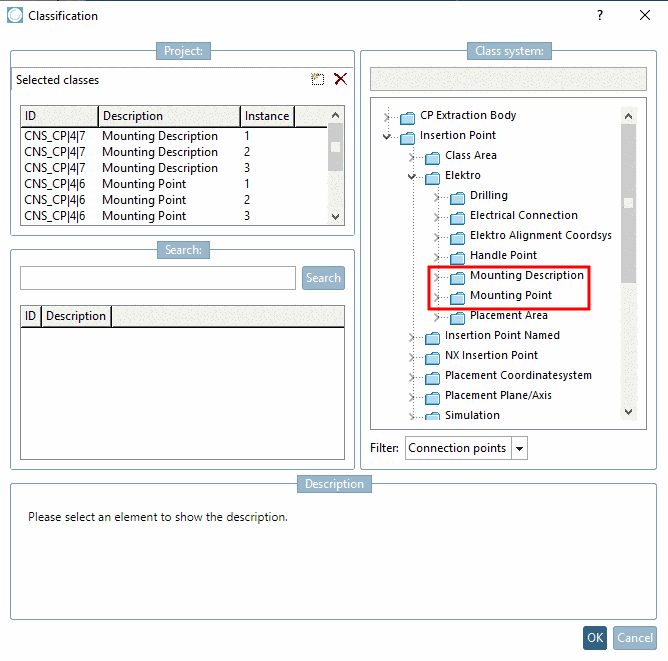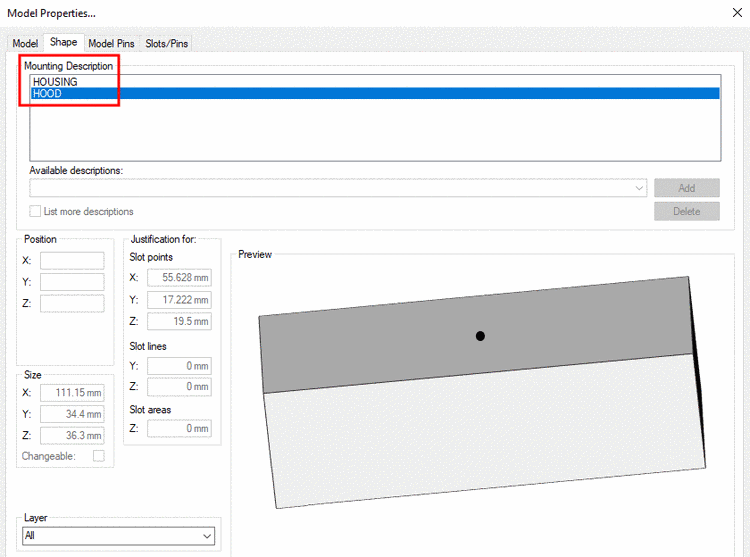Manual
Login
Our 3D CAD supplier models have been moved to 3Dfindit.com, the new visual search engine for 3D CAD, CAE & BIM models.
You can log in there with your existing account of this site.
The content remains free of charge.

Top Links
Manual
Beside the Connection points classifications for Electrical Connection, the Connection points classifications Mounting Point (CNS_CP|4|6) and Mounting Description (CNS_CP|4|7) are especially important.
All mounting points have to be equipped with a Connection point.
These connection points are classified as Mounting Point or Mounting Description.
Mounting Point describes at which places of the component other components can be mounted.
Mounting Description describes point and direction where the part itself can be plugged into a compatible component.
This is differently supported by CAD systems.
Zuken E3: Here, building assemblies via Mounting Points is only rudimentarily supported. I.e. parts can only be plugged in direction of the Z axis. Fitting (compatible) parts are modelled via system of mounting description and the slot description. Furthermore a part may have only one position for the Mounting Description (but several mounting description strings. The direction of the Mounting Description gets lost during the export to E3.
The procedure of classifying with Mounting Point (CNS_CP4|6) is standard.
At the class Mounting Description (CNS_CP4|7), the important point is the attribute Description. Its value will later be displayed as Slot name in E3 and says, that only parts whose Description attribute has the same value, may be plugged in. As different parts could be plugged in, there is a potential need to specify several values. As the CNS classification system does not support arrays, a special method is used. Details on this can be found below.
The figure exemplarily shows the value"HOOD" at the attribute "Description". Basically the name can freely be chosen, however, regard to give meaningful names.
Following figure
shows a part in Zuken E3 with 6 slots, respectively with description
"MODULE", meaning that the part can receive 6 subparts with Mounting
Description "MODULE".
This part itself
can be plugged into slots of other parts, if these Slots are named "HOUSING" or "HOOD". Note: Here we have a
Mounting Description
apparently managing 2 strings.
The schema of classifying is completely analogously to the classifying of electrical connections. The only difficulty is that there could be several "Descriptions". In this case the "utility class" CNSELEK|5|3 is used.
In the class CNSELEK|5|3, in the attribute Description, different values can be entered. In this way the Mounting Description manages an array of strings. Compare Fig. „"Mounting Description" in Zuken E3.“.
After having selected the Connection Point classified as Mounting Description (CNS_CP|4|7), the decisive point is the value under attribute Link ID. It references classes of the type CNSELEK|5|3 which are several times instantiated and which again have to have the same value under attribute Link ID. This class is the container for the Mounting Description strings, which are entered in the class of type CNSELEK|5|3, in the attribute Description.
| Link ID (attribute of CNSELEK|5|3) | Description (attribute of CNSELEK|5|3) | Instantiated by CNSELEK|5|3 |
| "Link 1" | "Description 1 of 3" | 1 |
| "Link 1" | "Description 2 of 3" | 2 |
| "Link 1" | "Description 3 of 3" | 3 |
Example: Mounting Description (CNS_CP|4|7) for an array with two entries.
So the component itself can be plugged into a "HOOD" or a "HOUSING".

![[Note]](/community/externals/manuals/%24%7Bb2b:MANUALPATH/images/note.png)





